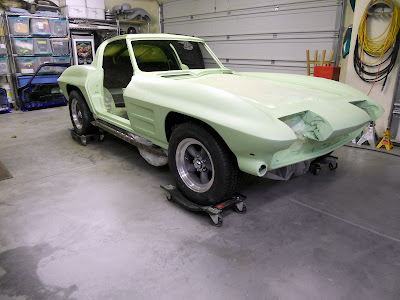It's time to prepare the body for primer sealer. But before we do that we have to fix this last little stinking blemish. One finger swipe of glazing compound did it. With that, the body work is done, done, done (less the doors, hood, headlight buckets and rear valance).
Because the primer has been curing for several days the surface needs to be roughed up so the next coat of paint will stick. House of Kolor recommends a maroon scuff pad and that's what we will use. In addition we will use Dura-Block, a sanding block that has properties similar to that of heavy shoe leather. The combination of the scuff pad and the sanding block will give us an even flatter/smoother surface. This will take several hours.
If you look close you can see that the scuff pad can remove a lot of material. You have to be very careful, especially along edges and corners.
When the scuffing was done I put the car on jack stands, removed the tires for access to the wheel wells, masked where needed, then wiped down the body with a post sanding cleaner.
We are using House of Kolor's black primer sealer called Ko-Seal II. This primer sealer is used to prevent the topcoats (color and clear coat) from soaking into our green primer. Without the primer sealer we would loose gloss over time. The primer sealer also acts as a bonding agent between the primer and the topcoats.
The paint booth was put up and ventilation was established before I started painting. I started painting in all the tough to reach places first. We want at least two full coats when we're done.
Door jambs, hood jambs, headlight recesses, tail light recesses, wheel wells, the exhaust valance and the entire perimeter of the bottom of the car make up the tough-to-reach areas. This was done using a SATA Mini-Jet spray gun, a small, high quality gun used for getting in tight spots.
I used my full size SATA HLVP spray gun for the body. OMG! It worked great but boy did it tax the capabilities of my makeshift paint booth. I am really glad I was wearing a respirator and paint suit.
When done I tore down the paint booth and put the wheels and tires back on. Thankfully my garage survived. No over spray anywhere... except for the camera.
It really looks nice.
Now I'll let it dry for at least a week. While that's happening I'll spend some time cleaning the camera.
The green is gone! Whoo hoo!



















































